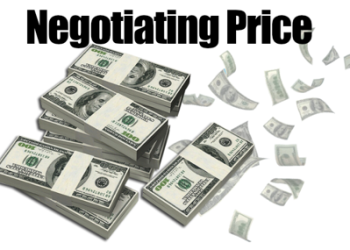I’ve written on this real estate blog about negotiating price and the importance of knowing what you’re doing when you draft an offer and negotiate the price. Not only can it mean the difference between reaching mutual acceptance with a seller or killing the deal, it can also mean tens of thousands of dollars to you.
Negotiating – Mistakes People Make
Experienced negotiators have seen many patterns of behavior over the years, and they learn all the nuances of negotiating. Amateurs think in simple terms, like take the listing price and offer 5% less. Or amateurs assume if a listing has been on the market for 100 days that the home is overpriced, and its time to make a low ball offer. There are a hundred immature negotiating approaches I have seen people and their agents take over the last four decades. The crazy thing is they are totally confident they know what they’re doing. That’s the problem with knowing just enough to be dangerous, and it can cost you a lot of money.
Today I’ll share one example of what I’m talking about. Realize that this is one of hundreds of examples, so you will see why I say negotiating is not for amateurs. I represented a buyer who spent a lifetime working as an engineer. The seller who was represented by another agent was a very creative artist. So when we went into the negotiations what did I know, and what could I anticipate?
Negotiating: Engineer v. Artist
An engineer thinks like an engineer. Do you know what I mean? A trained engineer is logical, calculated, unemotional, and cautious in making a final decision. An engineer wants to look at hard data when determining what price to offer, and he knows in advance what price range still comports with the prices of comps and the replacement cost approach. An engineer can be a great client, but can also go to extremes in analysis.
The seller was super creative and quite an artist in life on several levels. A creative seller does not think like an engineer. An artist thinks not about mathematical comparisons, but about the design contributions she has made to her home since she has owned it, and those designs have great artistic value to her, and deep emotional connections. Her home became an extension of her inner self, and she loved her home. The value of her home cannot be adequately represented by the cost approach or a comparative market analysis.
Both of these people are good people and are exactly who they were meant to be. But negotiating without an understanding of their differences and how they approach negotiating can be a recipe for disaster. This is especially true if the creative artist’s own real estate agent is also a creative type of person. Going into this negotiation, I knew a creative artist type will often make unreasonable demands that have no basis in a careful real estate analysis, and I knew my engineer would walk rather than agree to a price propped up by a seller’s intense emotions. Our entire approach needed to address each party’s special concerns and feelings. We did reach mutual acceptance, and in the end everyone was very pleased. Imagine not understanding this going into the negotiations. This is why buyers and their agents often get frustrated and angry and walk away.
Negotiating is part science and part art, but negotiating is definitely not for amateurs when tens of thousands of dollars are at stake.
Last Updated on August 3, 2022 by Chuck Marunde

































